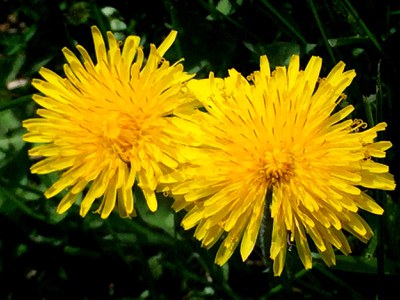Spraying Dandelions in Lawns
 The most common perennial flower in North Dakota may be the dandelion.
The most common perennial flower in North Dakota may be the dandelion.
Some gardeners tolerate dandelions while other gardeners attack them with a vengeance.
Killing one dandelion is easy, but killing all of them is nearly impossible and a never-ending battle. A single dandelion plant can produce over 2,000 seeds!
Let’s focus on maintaining an attractive and healthy lawn with a judicious use of herbicides:
Choose the right herbicide. Dandelion, as well as clover, thistle and ground ivy, are broadleaf (non-grassy) weeds.
The most effective broadleaf-killing herbicides for lawns are Trimec formulations. These products consist of a combination of three herbicides (2,4-D, mecoprop and dicamba). Quinclorac is a recent addition to many broadleaf weed formulations. These formulations are powerful but also poisonous.
Dicamba is particularly effective, but it can persist in the soil and cause damage to nearby trees, shrubs and perennials. This is all the more reason why herbicides should be limited in their use.
Herbicides that control weeds in pastures and rangeland are commonly used in rural areas of North Dakota. These herbicides, including Milestone and Tordon, will kill weeds in residential lawns, but they may also damage trees, shrubs and other plants in your landscape.
Spray only when needed. These herbicides are poisonous. Use them only when necessary, and then only when most effective.
Herbicides are most effective when used in fall (not in spring). The key to killing weeds is to get the herbicide down into the roots.
In fall, weeds naturally channel their nutrients down into their roots in preparation for winter. If sprayed in fall, the weeds will naturally send the herbicide, along with their nutrients, down into the roots.
Herbicides sprayed in spring will not be as readily transported through a weed’s root system. Repeated applications may be required.
Use spot sprays. Instead of spraying your entire lawn, focus your sprays in the weedier areas of your lawn, spraying the weeds themselves. This will reduce your exposure to the toxic chemicals and save you money.
Spray under the right conditions. Drift from herbicide sprays may damage vegetables, flowers, trees and shrubs in your landscape.
Avoid spraying when winds exceed 5 MPH. Avoid spraying when temperatures approach 90 degrees or warmer. Drift may occur under foggy conditions.
When needed, cover or shield your desirable plants from nearby sprays.
Avoid spraying with a fine mist. Heavy droplets are less likely to volatilize.
Promote a thick, healthy lawn. Cut your turf tall. The tall blades will shade out the emerging weeds and prevent them from getting established.
Do not collect grass clippings. The clippings in your lawn can smother out emerging weed seedlings. The clippings can also promote a stronger, thicker turf by keeping the soil cool and moist, as well as recycling nutrients back into the soil.
Fertilizing your lawn can enhance its thickness and reduce the establishment of weeds.
Written by Tom Kalb, Extension Horticulturist, North Dakota State University. Photo courtesy of *creativ*contrasts.





